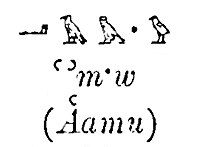| |||||
| Aamu in hieroglyphs | |||||
|---|---|---|---|---|---|

(𓋾𓈎𓈉 ḥḳꜣ-ḫꜣswt, Heqa-khasut for "Hyksos").
Tomb of Khnumhotep II, circa 1900 BCE.[1]
Aamu (Ancient Egyptian: 𓂝𓄿𓅓𓅱, romanized: ꜥꜣmw) was an name used to designate West Asians in ancient Egypt.[1] It is often translated as "Western Asiatic", but it might refer specifically to Canaanites or Amorites.[1][2] The Egyptologist and linguist Thomas Schneider states that ꜥꜣm was attested as early as the Sixth Dynasty of Egypt and is likely a loanword from early Semitic term drmj, "inhabitant of the south (of Palestine)".[5]
Contemporary Egyptian sources from the time of the wars against the Hyksos also refer to the latter as ꜥꜣmw. Although they have left no inscriptions in their own language, some of their personal names have turned up in Egyptian records, which are a syntactical and lexical match for West Semitic dialects.[6] An ancient Egyptian painting in the tomb of 12th Dynasty official Khnumhotep II, at Beni Hasan (c. 1900 BCE), shows a group of West Asiatic foreigners, possibly Canaanites, labelled as Aamu (ꜥꜣmw), including the leading man with a Nubian ibex labelled "Abisha the Hyksos" (𓋾𓈎𓈉 ḥḳꜣ-ḫꜣsw, Heqa-khasut for "Hyksos").[1][2][3][4] The Aamu from this relief are further labeled as being from the area of Shu, which may be identified, with some uncertainty, with the area of Moab in southern Palestine around the Jordan River, or generally the southern Levant, just east of the Jordan and the Red Sea.[7]

-
Word "Aamu" (from right to left) in two Egyptian scripts, in the
-
A more recent description of the word (left to right, 1898)
-
Aamu people ('𓂝𓄿𓅓𓅱' characters spread alongside each individual) in the Book of Gates (rendering)
- ^ a b c d e Mieroop, Marc Van De (2010). A History of Ancient Egypt. John Wiley & Sons. p. 131. ISBN 978-1-4051-6070-4.
- ^ a b c Bard, Kathryn A. (2015). An Introduction to the Archaeology of Ancient Egypt. John Wiley & Sons. p. 188. ISBN 978-1-118-89611-2.
- ^ a b Curry, Andrew (2018). "The Rulers of Foreign Lands - Archaeology Magazine". www.archaeology.org.
- ^ a b Kamrin, Janice (2009). "The Aamu of Shu in the Tomb of Khnumhotep II at Beni Hassan". Journal of Ancient Egyptian Interconnections. 1 (3). S2CID 199601200.
- ^ Schneider, Thomas (20 June 2023). Language Contact in Ancient Egypt. LIT Verlag. p. 75. ISBN 978-3-643-96507-3.
- ^ Redford, Donald B. (1992). Egypt, Canaan, and Israel in Ancient Times (1st ed.). Princeton University Press. p. 100. ISBN 0-691-03606-3.
- ^ Kamrin, Janice (2009). "The Aamu of Shu in the Tomb of Khnumhotep II at Beni Hassan". Journal of Ancient Egyptian Interconnections. 1 (3): 25. S2CID 199601200.
- ^ Ancient Sculpture and works of Art part II, Sotheby's, 2019 "It is possible that this object formed part of the handle of an implement; " This piece was later in headlines for controversy. https://archive.today/20231226213938/https://www.telegraph.co.uk/news/2022/12/03/archaeologist-urges-sothebys-cancel-auction-illicit-artefacts/


